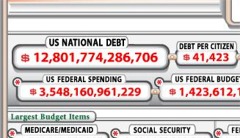|
Digital News Report – The federal government, since the collapse of the Soviet Union, has gone on a spending spree that has brought it to the point of default.
In 1991 the federal government’s total budgeted debt was $3.6 trillion.
As of this writing, at 7:23 am on Sunday, April 11, the government’s on budget debt was $12.788 trillion and increasing at a rate of roughly $10,000 per half second.
Budgeted debt is stressed here because the total unfunded liabilities of the federal government, that are not part of the budget, were approaching $100 trillion as of August, 2008.
In answer to this rapidly growing debt, the government is enacting a plan to manage the delivery of medical services that will cost an estimated $1.5 trillion over 10 years. This projection, however, is made before the bureaucratic mechanisms are even taking shape. It is difficult to take government claims of the costs of the program seriously when White House spokesman, Reid Charin says, “Here’s what we do know: The reserve fund in the president’s budget is fully paid for and provides a substantial down payment on the cost of reforming our health care system.” How can anything our government does be fully paid for when, as of 7:50 am, April 11, the budgeted debt is $12.789 trillion dollars. The deficit has increased by a billion dollars in less than one half hour, and it is increasing more rapidly by the second.
The notion is suggested here that the experts of government, finance, and industry who have worked so diligently to increase the federal debt by nearly $10 trillion since America became the world’s lone super power do not have the solutions to reduce this debt burden on all of us.
What can the average person do to confront and turn back the coming turmoil that will come when the world recognizes the Federal Government of the United States is insolvent? How can a sound, free market economy rise from the ashes of the Keynesian centrally-planned, debt ridden system that experts have based upon fiat currency?
The Financial Dictionary defines “economy” thusly, “The large set of inter-related economic production and consumption activities which aid in determining how scarce resources are allocated.” American government has led the way in establishing the faith that spending and consuming drive economic growth. Corporate manufacturers have convinced Americans that cheap labor helps keep prices low so as to drive consumption. Therefore, they have been using abandoning the American labor market for cheaper workers from third world countries. The reduction in labor costs have made their products more affordable, but the millions of Americans who have lost manufacturing jobs over the past decade cannot afford to buy them.
The productive labor of common folk is the source of things that people need and it also helps people earn the wages to provide for their needs. One of the contributors to the horrible debt threatening to wreck the American economic system is that the work of production has been stigmatized as being beneath American sophistication and too expensive in this country. The attitude of Americans toward work has even justified an uncontrollable flow of immigration to this country as, “Immigrants will do the work that Americans won’t do.”
According to Daniel Gross of Slate, among the jobs that Americans won’t do are, “…landscaping, …picking fruits and vegetables…busing tables, and prep cooking….” These are traditionally entry-level jobs that were once taken by entry-level workers. In a previous generation workers who performed these jobs were in their early teens or even preteens. Child labor restrictions, however, place strict work limits on anyone under 18 years old. Anyone under 16 years are virtually banned from taking these jobs. What has resulted is older teens entering the work force with no experience and many unable to meet necessary expenses with the low wages these jobs offer.
Furthermore, the corporate demand for cheap labor has sent manufacturing jobs, that once sustained the American middle class, to third world countries, many of which exploit the child labor that is limited for even entry level jobs in this country. As the revenues that were generated by American labor of all ages has diminished, though, the numbers of government workers continue to grow to the point that government now accounts for the same percentage of Gross Domestic Product as does manufacturing. The big problem with that is that government workers do not produce anything but onerous regulations that drive up the cost of labor in this country.
The productive labor of common Americans built the nation to its strength. That strength has been sold out by political and corporate leaders who let their lust for personal gain kill any honor for the free, self-sufficient republic that was once America.
It is now 8:45 pm on Sunday, April 11. This article was begun 13 hours ago. The federal debt is now $12.801 trillion dollars. It will be $13 trillion by mid week.
How are we going to work our way out of this one?
By Bob Strodtbeck
Bob Strodtbeck has been writing editorial commentaries since 1993. He has professional experiences in pharmaceuticals, radio, and education. He has also served as a church elder in an Orlando congregation where he has made his home since 1986.

